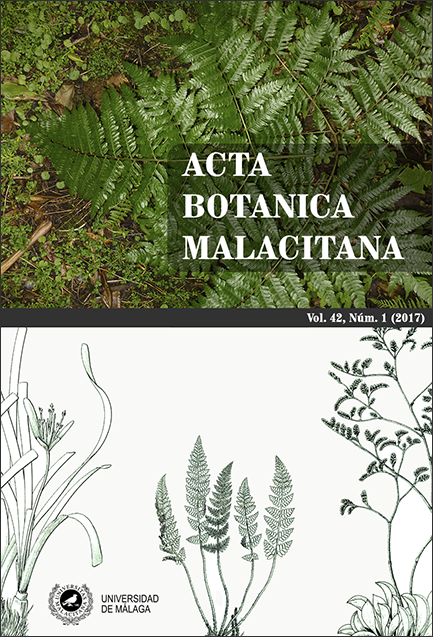Fase gametofítica de las tres variedades de Argyrochosma nivea (Pteridaceae).
DOI:
https://doi.org/10.24310/abm.v42i1.3008Abstract
La finalidad de este trabajo es describir características de la fase gametofítica de Argyroschoma nivea con el objeto de caracterizar esta fase del ciclo de vida y aportar evidencias a las relaciones entre las tres variedades de la especie (var. flava, var. nivea, y var. tenera). Para ello se consideraron cantidad de esporas por esporangio, tamaño de las esporas y se obtuvieron los gametofitos mediante cultivos en medios estériles. Se realizaron observaciones mediante microscopía de luz y electrónica de barrido. Se encontró que las tres variedades presentan 32 esporas por esporangio, comparten idéntico patrón de germinación, desarrollan gametofitos cordiformes asimétricos, y su reproducción es apogámica, de tipo obligada en las var. nivea y tenera. Los esporofitos de la var. flava desarrollan tricomas secretores de farina de color blanco sobre toda la superficie.
Downloads
Metrics
References
Edwards, M.E. & Miller, J.H. (1972). Growth regulation by ethylene in fern gametophytes. III. Inhibition of spore germination. Amer. J. Bot. 59: 458-465.
Gabriel y Galán, J. M. (2011). Gametophyte development and reproduction of Argyrochosma nivea
(Pteridaceae). Biologia 66(1): 50-54.
Gastony, G.J. & Windham, M.D. (1989). Species concepts in Pteridophytes: the treatment and definition of agamosporous species. Amer. Fern J. 79: 65-77.
Hernández, M.A., Andrada, R.A., Páez, V. A. & Martínez,
O.G. (2015). Ploidy level and obligate apogamy in Argyrochosma nivea (Poir.) Windham var. tenera (Pteridaceae). Hoehnea 42(2): 233-237.
Hayes, D.W. (1924). Some Studies of Apogamy in Pellaea atropurpurea. (L.) Link. Transact. Microsc. Soc. 43(3): 119 -135.
Hevly, R.H. (1963). Adaptations of cheilanthoid ferns to desert environments. J. Arizona Acad. Sci. 2: 164-175. Johnson, A.K., Rothfels, C.J., Windham, M.D. & Pryer,
K.M. (2012). Unique expression of a sporophytic character on the Gametophytes of notholaenid ferns (Pteridaceae). Amer. J. Bot. 99(6): 1118-1124.
Knobloch, I.W. (1966). A preliminary review of spore number and apogamy within the genus Cheilanthes. Amer. Fern J. 56(6):163-167.
Knobloch, I.W. (1969). The spore pattern in some species of Cheilanthes. Amer. J. Bot. 56(6): 646-653.
Martínez, O.G. (2010). Gametófitos y esporófitos jóvenes de cuatro especies naturalizadas de Pteris (Pteridaceae) en América. Rev. Biol. Trop. 59(1): 81- 92.
Martínez, O.G., C. Prada, Tanco, M.E. & Bonomo,
M.C. (2013). Sexual phase of three species of Pteris
(Pteridaceae). Trop. Plant Biol. 6(1):46-52.
Morbelli, M.A., Ponce, M.M., Macluf, C. & Piñeiro, M.R. (2001). Palynology of South American Argyrochosma and Notholaena (Pteridaceae) species. Grana, 40: 6, 280-291.
Nayar, B.K. & Bajpai, N. (1963). Morphology of the gametophytes of some species of Pellaea and Notholaena. J. Linn. Soc. Bot. 59: 63-76.
Nayar, B.K. & Kaur, S. (1971). Gametophytes of homosporous ferns. Bot. Rev. 37: 295–396. Ponce, M.M. (2016). Argyrochosma (J. Sm.) Windham, in: Zuloaga F.O. & M.J. Belgrano & A.M. Anton (eds.). Flora vascular de la República Argentina II. pp. 285-
Sigel, E.M., Windham, M.D. Huiet, L. Yatskievych, G. & Pryer, K.M. (2011). Species relationships and farina evolution in the cheilanthoid fern genus Argyrochosma (Pteridaceae). Syst. Bot. 36: 554-564.
Steil, W. N. (1933). New Cases of Apogamy in Certain Homosporous Leptosporangiate Ferns. Bot. Gaz. 95 (1): 164-167.
Tryon, R.M., Tryon, A.F. Kramer, K.U. (1990). Pteridaceae, in: Kubitzki K. (ed.). The families and genera of vascular plants. Berlin: Springer-Verlag. I: 230-256.
Tryon, A. F. & Lugardon, B. (1991). Spores of the Pteridophyta. Springer, New York.
Tryon, R.M. & Tryon, A.F. (1982). Ferns and allied plants, with special reference to Tropical America. Springer- Verlag. New York.
Walker, T.G. (1962). Cytology and evolution in the fern genus Pteris L. Evolution 16: 27-43.
Windham, M.D. & Yatskievy, G. (2003). Chromosome studies of cheilanthoid ferns (Pteridaceae: Cheilanthoideae) from the western United States and Mexico. Amer. J. Bot. 90: 1788-1800.
Windham, M.D. (1987). Argyrochosma, a new genus of cheilanthoid ferns. Amer. Fern J. 77: 37-41.
Whittier, D.P. (1965). Obligate apogamy in Cheilanthes tomentosa and C. alabamensis. Bot. Gaz. 126 (4): 275-281.
Whittier, D.P. (1970). The initiation of sporophytes by obligate apogamy in Cheilanthes castanea. Am. J. Bot. 57(10): 1249-1254.
Wollenweber, E. & Schneider, D. H. (2000. Lipophilic exudates of Pteridaceae-Chemistry and chemotaxonomy. Biochem. Syst. Ecol. 28: 751-777.
Wollenweber, E. (1984). Exudate flavonoids of Mexican ferns as chemotaxonomic markers. Revista Latinoamer. Quím. 15: 3-11.
Woronin, H. (1907). Apogamie und aposporie bei einigen farnen. Ber. Deutsch. Bot. Ges. 25: 115-135.
Downloads
Published
How to Cite
Issue
Section
License
All information related to the licensing of published works in Acta Botanica Malacitana and copyright can be found in our Editorial Policy.







1.png)
